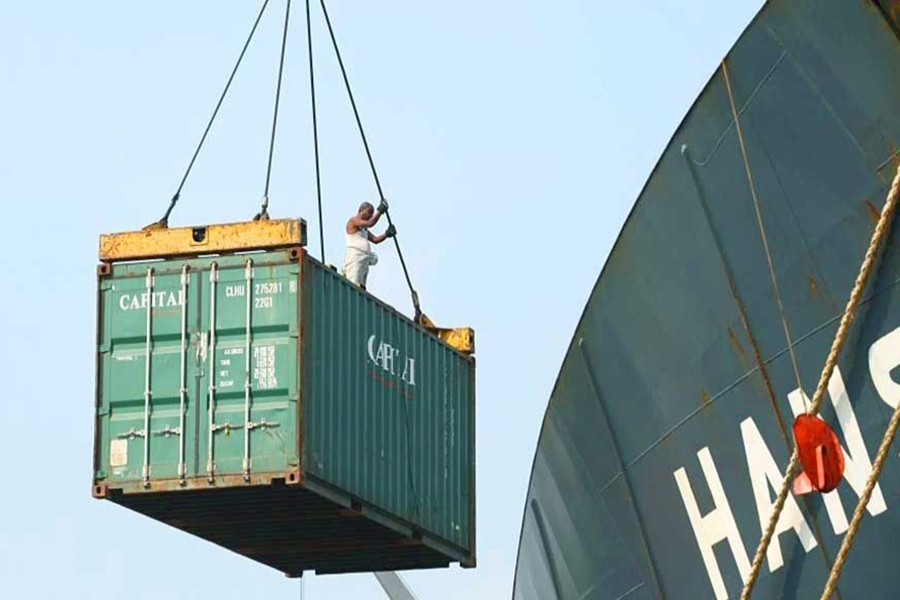
Published :
Updated :

Bangladesh's overall imports jumped by 52.5 per cent in the first seven months of this fiscal year (FY) due to higher imports of fuel oil and capital machinery, officials said.
The settlement of letters of credit (LCs), generally known as actual import, in terms of value, rose by US$15.66 billion to $45.48 billion during the July-January period of FY 2021-22 from $29.82 billion in the same period of the previous FY, according to the central bank's latest statistics.
An official said the high prices of essential commodities, including petroleum products, in the global market have pushed up the country's overall import payments during the period under review.
The opening of LCs, generally known as import orders, also grew by more than 49 per cent to $52.36 billion during the period under review from $35.12 billion in the same period of FY '21.
"The upward trend in imports may continue in the coming months ahead of the holy month of Ramadan," a senior official of the Bangladesh Bank (BB) told the FE on Thursday.
Opening of LCs for importing different consumer items are expected to rise from this month to meet the growing demand for the items mostly consumed in Ramadan, he added.
Usually, a large quantity of essential commodities is imported to meet the additional demand of consumers during the month.
The official said the country's import payment obligations have increased significantly in recent months as the overall economic activities are fully resuming after more than one-year of sluggishness, mainly caused by the Covid-19 pandemic.
Echoing the BB official, managing director (MD) and chief executive officer (CEO) of Dhaka Bank Limited Emranul Huq said the upward trend in imports may continue until the middle of May next.
The senior banker urged the authorities concerned to strengthen monitoring and supervision of the market to curb the import of 'unnecessary' luxurious items for keeping the country's foreign exchange market stable.
The import of petroleum products rose by 89.24 per cent to $4.04 billion during the period under review from $2.13 billion in the same period of FY'21.
The import of petroleum products may increase further in the coming months mainly due to seasonal impact, according to the central banker.
Meanwhile, the import of capital machinery or industrial equipment used for productions jumped by over 61 per cent to $3.05 billion during the July-January period of FY'22 from $1.89 billion in the same period of FY'21, the BB data showed.
The imports of capital machinery for readymade garment (RMG), leather, pharmaceuticals and electronics sectors have picked up significantly during the period under review, according to Mr Huq.
"The capital machinery is being mostly used for balancing, modernisation, rehabilitation and expansion (BMRE) of the existing industrial units to improve their productivity," he explained.
However, import of intermediate goods such as coal, hard coke, clinkers, scrap vessels, etc. surged by more than 58 per cent to $4.02 billion during the period under review from $2.54 billion in the same period of FY '21.
"Normally, construction materials, imported as intermediate goods, pushed up the overall import payments in the first seven months of FY '22," another BB official told the FE.
He also said that different mega infrastructure projects, including Padma Bridge and metro rail, largely contributed to the increased imports of intermediate goods.
Besides, import of industrial raw materials jumped by more than 52 per cent to $16.61 billion during the July-January period of FY '22 from $10.88 billion in the same period of the previous fiscal year.
On the other hand, import of consumer goods jumped by more than 49 per cent to $5.16 billion during the period under review from $3.46 billion in the same period of FY '21, the BB data showed.
Meanwhile, Bangladesh's current-account deficit exceeded the $10-billion mark during the period under review following the higher import payments alongside lower inflow of remittances.
The current-account deficit rose to $10.06 billion during the July-January period of FY'22 from $8.18 billion a month ago. It was a $1.56 billion surplus in the same period of FY'21.
Inward remittances dropped by nearly 20 per cent to $11.94 billion in the first seven months of FY'22 from $14.91 billion in the same period of FY'21, the BB data showed.
Experts, however, predict that the widening current-account deficit may continue in the coming months if the lower inflow of remittances and higher import expenses persist.
siddique.islam@gmail.com


 For all latest news, follow The Financial Express Google News channel.
For all latest news, follow The Financial Express Google News channel.